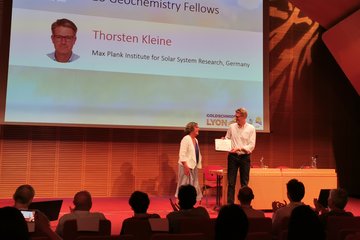Alle Typen
81.
Zeitschriftenartikel
Pre-Impact Mid-IR and Optical Observations of Comet 9P/Tempel 1. Earth, Moon and Planets 97, S. 331 - 339 (2005)
82.
Zeitschriftenartikel
Near-Earth asteroid search and follow-up beyond the 22nd magnitude: A pilot program with ESO telescopes. Astronomy and Astrophysics 418, S. 743 - 750 (2004)
83.
Zeitschriftenartikel
Surface characterization of 28978 Ixion (2001 KX76). Astronomy and Astrophysics 415, S. L21 - L25 (2004)
84.
Zeitschriftenartikel
Aqueous altered silicates at the surface of two Plutinos? Astronomy and Astrophysics 416, S. 791 - 798 (2004)
85.
Zeitschriftenartikel
Simultaneous visible and near-IR photometric study of Kuiper Belt Object surfaces with the ESO Very Large Telescopes. Astronomy and Astrophysics 417, S. 1145 - 1158 (2004)
86.
Zeitschriftenartikel
ESO Large Program on physical studies of Transneptunian Objects and Centaurs: Final results of the visible spectrophotometric observations. Astronomy and Astrophysics 421, S. 353 - 363 (2004)
87.
Zeitschriftenartikel
Visible spectroscopic and photometric survey of L5 Trojans: Investigation of dynamical families. Icarus 172, S. 221 - 232 (2004)
88.
Zeitschriftenartikel
The spectrum of Comet C/1999 H1 (Lee) between 0.6 and 1 micron. Astronomy and Astrophysics 420, S. 371 - 382 (2004)
89.
Zeitschriftenartikel
Gas and Dust in Comet C/2000 WM1 during its closest approach to Earth: Optical imaging and long-slit spectroscopy. Astronomy and Astrophysics 422, S. 717 - 729 (2004)
90.
Zeitschriftenartikel
ESO Large Program and Centaurs and TNOS: Visible colors - final results. Icarus 170, S. 153 - 166 (2004)
91.
Zeitschriftenartikel
Rosetta target Comet 67P/Churyumov-Gerasimenko: Post-perihelion gas and dust production rates. Astronomy and Astrophysics 422 (1), S. L19 - L21 (2004)
92.
Zeitschriftenartikel
A search for circumstellar dust disks with ADONIS. Astronomy and Astrophysics 424, S. 613 - 618 (2004)
93.
Zeitschriftenartikel
Sublimating components in the coma of Comet C/2000 WM1 (LINEAR). Astronomy and Astrophysics 424, S. 325 - 330 (2004)
94.
Buch
Rosetta-ESA's Mission to the Origin of the Solar System. Springer Press, Heidelberg (2009)
95.
Buch
The Solar System Beyond Neptune. University of Arizona Press, Tucson, USA (2008)
96.
Buchkapitel
Sonnensystem - Überblick. In: Abriss der Astronomie, S. 57 - 60 (Hg. Röser, H.-J.; Tscharnuter, W.). Wiley-VCH Verlag (2012)
97.
Buchkapitel
Die Planeten und ihre Monde. In: Abriss der Astronomie, S. 104 - 128 (Hg. Röser, H.-J.; Tscharnuter, W.). Wiley-VCH Verlag, Berlin (2012)
98.
Buchkapitel
Kometen. In: Abriss der Astronomie, S. 137 - 145 (Hg. Röser, H.-J.; Tscharnuter, W.). Wiley-VCH Verlag, Berlin (2012)
99.
Buchkapitel
Rosetta Lander (Philae) Investigations. In: Rosetta-ESA's Mission to the Origin of the Solar System, S. 589 - 603 (Hg. Schulz, R.; Alexander, C.; Boehnhardt, H.; Glassmeier, K.-H.). Springer Press, Heidelberg (2009)
100.
Buchkapitel
Asteroids and Kuiper Belt Objects. In: Handbook of Practical Astronomy, S. 483 - 498 (Hg. Roth, G. D.). Springer Press, Berlin (2009)











